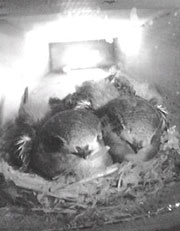The swifts in the tower
The European swift, Apus apus, spends virtually its entire life in flight. It feeds, sleeps, and collects nesting material on the wing, and can sometimes even mate without alighting. Normally the only time a swift stops flying is when it is breeding. The Museum tower is a nesting site for European swifts and they are a familiar summer sight here. When the young leave the Museum they may never stop flying until three years later when they return as adults to nest themselves.

Life on the wing
Swifts are migratory birds. European swifts from Britain winter in Zaire, Tanzania or Zimbabwe. They have long, thin wings for efficient gliding flight over long distances. Their beaks have a wide gape to catch a variety of insects and tiny spiders while on the wing. Swifts will fly hundreds of kilometres a day while feeding. Their short legs and strong feet are used for hanging on to vertical surfaces, crawling into their nests or fighting an intruder.
What do swifts eat?
Swifts feed on nearly all types of flying insects, from minute thrips, to large hoverflies. They also eat spiders, who, although terrestrial, can be found at great heights, as they often travel by launching themselves in the breeze and may be whisked up into the air. The chicks await their parents return to the nest, when they too receive an insect meal in the form of regurgitated mass or 'bolus'.
Life in the tower
Swifts have an exceptionally long life span for their size. Once they reach adulthood they usually live for about 6 years; one individual was 18 years old when last seen! They are extremely faithful to their nesting site, returning to the Museum tower year after year. They start to arrive in the last days of April and the fledglings usually leave around the beginning of August, followed by their parents a week or so later.
The males usually arrive first and take possession of the nest box. Mating takes place and two or three eggs are laid, normally in the last week of May, about a fortnight after the female's arrival. Both parents brood the eggs, and the incubation takes about 19 days. The eggs hatch around the middle of June and both parents feed the naked nestlings. They bring them small balls of food, packed into their throat, which consist of hundreds of tiny insects and spiders held together by saliva. The nesting period of swifts at Oxford varies from five to eight weeks. The young swifts leave the nest independently of their parents when their wings have reached full or nearly full length.
Parasites
Whilst the swift is nesting it is attacked by a parasitic louse-fly Crataerina pallida. This fly spends its entire life in and around the swifts' nest. The adults produce larvae in the late summer which immediately pupate and lie dormant all winter. They then hatch out when the first swift eggs are laid and feed on the nestlings and adults, sucking about 25mg of blood every 5 days. They can be a serious pest of both adults and nestlings.
Coping with the cold
Swifts are restricted to areas where the temperatures allow insects to keep flying in some numbers. This can be a problem in the northern part of their range, including Britain, when the weather turns cold, wet and windy, and food become scarce. Swifts have a number of adaptations to cope with this. Adult birds can store considerable subcutaneous fat and can roost at the nesting site for several days in torpor, slowing their metabolism and lowering their body temperature. Swift eggs can also withstand considerable chilling, and observations at Oxford have shown that chicks can survive fasts of up to 10 days and a weight loss of up to 50%.
The Oxford Swift Research Project
The colony of swifts which nest in the Museum has been the subject of a research study since May 1948. It is one of the longest continuous studies of a single bird species in the world, and has contributed much to our knowledge of the swift.
Swifts had been nesting inside the ventilator shafts of the Museum tower for many years when David Lack, the head of the Edward Grey Institute at the Department of Zoology, began the swift research project. Swifts use nesting sites which are inaccessible to predators to safeguard the eggs and chicks. The parents are also quite vulnerable when nesting. Swifts had proved a difficult species to study as they spend most of their lives in the air, but Lack realised that the swift colony in the Museum would be ideal for long term research.
The book Swifts in a Tower was first published in 1956 and details David and Elizabeth Lack's work on the colony of swifts in the Museum. It describes the setting up of the project and reviews other swift species.
Viewing the swifts
The swifts' nest boxes are well hidden within the tower and accessing them is near impossible to all but the most intrepid researcher. So, to let everybody take a peek at the growing chicks, cameras have been installed in three of the nest boxes. The images from the cameras are relayed to a monitor in the Museum, and are available on the Museum's website when the boxes are occupied.
Swifts in the tower - statistics and other information
The swifts in the tower (May to August only)
This article is also available as a fully illustrated PDF
Learning more ... The swifts in the tower (PDF, 240kB)
To read this file you will need to download Adobe Reader
Learning more articles are free to all users for educational, non-profit purposes.
